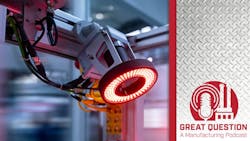Podcast: The ins and outs of machine vision — Unlocking new opportunities in manufacturing
In manufacturing, precision is paramount. Manufacturers are constantly seeking technologies that can enhance quality control, improve efficiency, and reduce human error. In this episode, New Equipment Digest editor-in-chief Laura Davis discusses the ins and outs of machine vision including what it is, its benefits, its challenges, its differences from other technologies, and more.
This information was originally written by John D. Thrailkill, marketing manager at Advanced Illumination. Bringing over a decade of experience, John initially started in engineering working on product designs which was followed by time spent in the applications lab, giving him firsthand insight into both the technical aspects and practical applications of machine vision technology.
Below is an excerpt from the podcast:
In simple terms, machine vision enables computers to see. Most authorities in the industry define machine vision as the replacement of human visual perception and judgment with a camera, computer, and software to provide autonomous, noncontact image acquisition, analysis, and decision-making to obtain desired data to enhance or control an automated process.
The industry generally assigns the basic machine vision use cases into the four following categories:
Category number one is inspection: A visual inspection includes identifying objects and features, verifying assembly, detecting defects, and counting.
Category number two is location and guidance: As in vision-guided robotics, the location of individual objects in a scene can be determined either relative to the scene or relative to a real-world coordinate system.
Category number 3 is measurement: In 2D and 3D space, online metrology provides real-world measurements of objects/features to a specified precision.
And category number 4 is identification, sorting, and reading. This category includes identifying and sorting objects and features in a scene, reading and understanding characters and code symbols, and sorting and counting objects according to geometry, color, or other characteristics.
